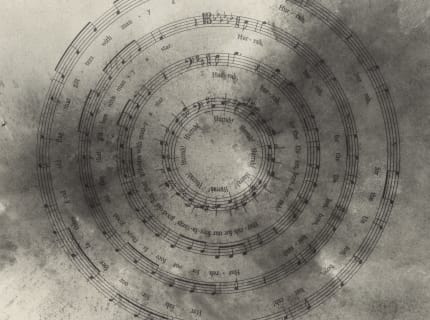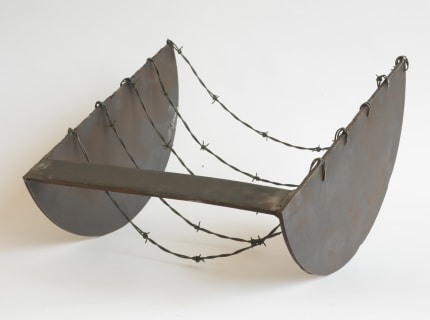Why do collectors collect? “Solidary & Solitary: The Joyner/Giuffrida Collection,” a knockout show at the Smart Museum of Art, offers a distinctive opportunity to consider this question.
The exhibition, of mostly abstract art by a multigenerational array of black artists ranging from Norman Lewis to Bethany Collins, is drawn from the private holdings of Pamela Joyner and Alfred Giuffrida, a San Francisco couple whose wealth derives from their respective careers in finance. In 2019, as museums divest from the opioid-epidemic-derived fortune of the Sackler family and the Whitney faces mounting protests over its vice-chairman Warren Kanders’s ownership of Safariland, a global defense equipment manufacturer, it is ever more important to know where the money comes from. So, let’s get that out of the way: Joyner, who grew up in Chicago, is the founder of Avid Partners, a financial marketing consultancy; Giuffrida, formerly a corporate lawyer, is a managing director at Horsley Bridge Partners, an investment firm.
The Joyner/Giuffrida Collection is consequential because the couple have not amassed art for the reasons that motivate other major fine art buyers today: the desire for unique items of great beauty, a proximity to the elite echelons of the creative classes, the thrill of high-stakes acquisitions, the possibility of “artwashing” dubious riches, and, increasingly, great investment opportunities. If some of the more benign of these explanations apply, they are nevertheless overwritten by Joyner and Giuffrida’s central mission — even by the very fact of having one, a rarity among collectors. Joyner laid out their plans in a 2017 interview: “For us it comes from a place of being committed to excellence — and equality. As I say, race is simply not a good lens through which to view art. But when the quality is there and has been overlooked, that’s where our mission comes in: the attempt to re-frame art history, to put these excellent works into the full context of the canon. If that’s a quest for social justice, I’m guilty of it.”
Proceeding strategically, Joyner and Giuffrida have built a collection of approximately 400 works, beginning with African-American artists and eventually expanding to the entire African diaspora. They’ve stuck mainly with abstract painting but have made some exceptions along the way. They’ve focused on certain artists in depth, discovered affinities and personal connections between others, and decided to act as stewards of individual careers. What this sounds like is generous and wise, and what it looks like is knock-’em-dead stunning to behold, though only a snapshot of it is on view at the Smart, where some 50 select works from the couple’s collection have been supplemented by a handful of loans and new site-specific commissions by a trio of Chicago artists. It’s humbling, too, especially for anyone schooled to believe in the canon, which traditionally has made precious little room for black artists, like the color field painter Sam Gilliam, who so obviously deserve major places there. The section devoted to Gilliam’s work includes the two most stirring pieces in the entire show — the symphonically effervescent “After Glow,” an enormous stained canvas from 1972, and “Stand,” a rainbow-hued swath of unstretched fabric bunched at the top and hung from a leather strap, one part drop cloth, one part laundry-hung-out-to-dry, one part sculpture.
Curated by Christopher Bedford and Katy Siegel of the Baltimore Museum of Art, the traveling show, which opened at the Ogden Museum in New Orleans in September 2017, positions abstraction as an especially fraught choice for black artists, continually under pressure to create a representational art that either matches racial stereotypes of their identity or conforms to community desire for uplift. The free expression granted white artists by birthright, especially white male artists, hasn’t been theirs. And yet they’ve claimed it: in Norman Lewis’s scratchy, staccato and uncommonly charming abstract expressionism; in Charles Gaines’s rigorously data-driven translations of trees and explosions; in Leonardo Drew’s exhaustively pieced-together wooden reliefs, so much more than the sum of their thousands of tiny parts; in Shinique Smith’s fabulously this-and-other-worldly, endlessly swirly collage paintings (though I sorely wish her hanging sculptures had been included, too).
As with any really good group exhibition, regardless of the premise, every visitor will find their own way. Mine included major stops at a set of five steel clusters, welded by Melvin Edwards from thick chains, padlocks, fencing, heavy bolts, a trowel, silverware, spikes, and axe heads — none of them blunted. Part of the “Lynch Fragments” series begun in 1963 and showing no signs of stopping (the examples here are from the 1990s and 2000s), they are unapologetically fierce, literal, reconstructive, and entirely new to me.
A grouping of seven wall pieces by Jennie C. Jones, all precisely constructed from musical materials like piano keys and acoustic absorber panels, marks my favorite presentation of her work yet: abounding in wit and restraint, a muted palette aglow with spare touches of neon yellow and hot pink, the final word in cool. Two eerily beautiful sculptures by Kevin Beasley — the youngest artist in the show and the hottest — belie the humdrum flowered housedresses and Yankees caps out of which they are constructed. Carved up, stiffened by resin, propped up by foam, or hung on a television stand, they retain their origins while moving on to something unexpectedly transcendent. That could be a motto for the entire collection.




